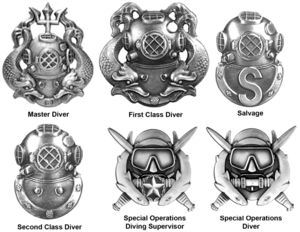Diving Badge
| Diver badges | |
|---|---|
 |
|
| Awarded by United States Army | |
| Type | Badge |
| Status | Currently awarded |
| Precedence | |
| Next (higher) | Flight surgeon badge |
| Next (lower) | Explosive ordnance disposal badge |
The diver insignia (also known as "diver badges") are qualification badges of the uniformed services of the United States which are awarded to servicemen qualified as divers. Originally, the diver insignia was a cloth patch decoration worn by United States Navy divers in the upper-portion of the enlisted service uniform's left sleeve during the first part of World War II, when the rating insignia was worn on the right sleeve. When enlisted rating insignia were shifted to the left sleeve in late World War II, the patch shifted to the upper right sleeve. The diving patch was created during World War II, and became a breast insignia in the late 1960s.
Currently, the United States Navy and the United States Army issue diver insignia and badges denoting degrees of qualification. The United States Coast Guard and United States Marine Corps personnel are eligible to earn most of the naval diver insignia.
United States naval diver insignia are awarded, per degree of qualification, to sailors, marines, and coast guardsmen. The elementary naval diver insignia is the scuba diver insignia, awarded upon qualifying as a basic naval diver. Previously, the scuba diver insignia was awarded in two degrees, one for officers and one for enlisted. The Navy eliminated the scuba diver officer insignia in the 1990s, but it remains in service within the Coast Guard. The silver-colored insignia features an old-fashioned diving mask and open-circuit breathing apparatus.
In 2001, the Marine Corps authorized the creation of a new badge, the combatant diver insignia, attesting to the wearer's closed-circuit rebreather and reconnaissance combat diver training; the gold-colored combatant diver insignia depicts a wetsuit hood, low-profile diving mask, and chest-mounted rebreather.
...
Wikipedia
